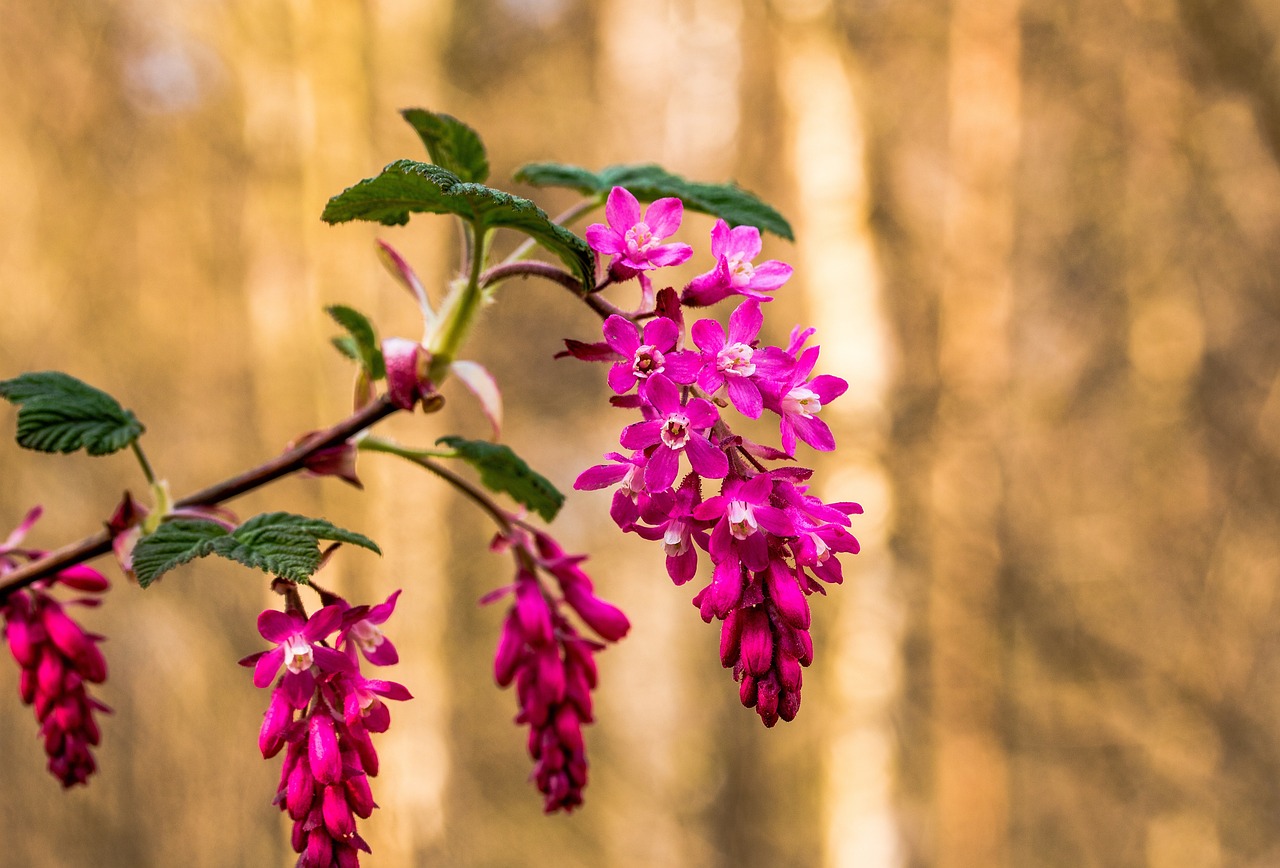Flowering Currant plants, or Ribes as they are also known, are a common sight in the UK in the spring.
They have ribbed leaves, dark berries, pink trailing flowers and a strong scent.
There is also a white version “White Icicle”
They do well in most soils and are easy to grow.
Sometimes however, they can suddenly start to fail.
So if you have asked the question “Why Is My Flowering Currant Dying?” then read on for answers and solutions.
Not Enough Sun
Flowering Currant plants enjoy a good amount of sunshine and will do best in full or partial sun.
This means either a full day in sun or at least half a day.
If situated in the shade, growth will tend to be a bit leggy and you may find your plant leans as it searches for the light.
There may also be less flowers and so less berries.
How to fix:
- When planting out new Flowering Currants, choose a sunny spot.
- If you have a plant situated in the shade that is not doing too well, consider moving it.
- Flowering Currants do not mind being moved as long as it is done in the autumn as the plant enters dormancy.

How to Move a Flowering Currant:
- Make the move in the early morning as this is when the plant holds the most water and so minimises the chance of shock.
- Prepare the hole in advance.
- Dig around the root ball and remove as much of the root system as possible and some of the surrounding soil.
- Transfer over to the new hole quickly and carefully, firm in and water in well.
- Keep watering once a week until the winter, unless there is ample rainfall.
- The plant should establish and you should see new growth in spring.
Soil With Poor Drainage
Flowering Currants like a fairly rich moist soil but are quite happy in most conditions.
They do need good drainage however and will not perform as well in heavy waterlogged soils.
This can cause the roots to decay which can kill the plant.
This can happen quite quickly and will show as poor growth, followed by die back of foliage and sections of branches.
How to fix:
- If your soil is heavy and prone to water saturation, work in some grit or sand to improve drainage.
- Don’t overwater – you will likely not need to provide extra water to a Flowering Currant as they are quite drought resistant (unless the weather is unusually hot).
- Take note of where your plant is located – is it in a spot where water accumulates?
- If so, consider moving it following the steps above.

Overly Alkaline Soil – High pH Level
Although Flowering Currants are a fairly forgiving plant and will grow in most places, they prefer a slightly acidic soil (6 – 6.5 pH level, where 7 is neutral).
They will struggle in very alkaline conditions (over 8.5 pH).
This can occur in areas of limestone, and arid areas where there is little rainfall.
These conditions can cause mineral or nutrient deficiencies because high alkaline levels prevent proper absorption through the roots.
Even if the nutrients are there, the plant can’t take them up.
This can show as poor growth and yellowing of leaves.
How to fix:
- The best way to adjust your soil if it is too alkaline is to add lots of organic matter like compost.
- You can also dig in coffee grounds.
- Peat is no longer recommended as it is not sustainable.
- Another option if you have very alkaline soil is to garden in containers.
- Flowering Currants do quite well in containers provided the container is nice and big, and has got really decent drainage.
- You can also prune them to stop them getting too large.
Not Enough Water
Although Flowering Currants are very drought tolerant, in extremely hot and dry conditions they can experience drought stress.
This can sometimes happen if the plant is situated close to tarmac, which can heat up in the sun and dry the soil out underneath.
The leaves will wilt, or turn brown and crispy, then fall.
How to fix:
- During extremely hot conditions, provide your Flowering Currant with some extra irrigation.
- If it is located next to tarmac, remember to keep an eye on it and water if needed.
- If it looks like it is struggling, consider moving the plant following the steps above.
Fungus
If Flowering Currants find themselves in damp conditions, i.e. overwatered or in soil with poor drainage, they can become susceptible to different types of fungus.
Crown Rot or Armillaria Root Rot “Honey Fungus”
These are fungi that will cause decay to the trunk and root system of Ribes and other woody shrubs.
They spread underground through the soil.
Armillaria Root Rot in particular can cause severe damage and often leads to the death of the plant.
It is characterised by white fungal growth under the bark starting at ground level.
The bark then starts to crack, seep and decay.
There is a strong mushroomy odour and there might be growth of honey coloured mushrooms around the base of the plant in the autumn.
How to fix:
- Unfortunately there is no cure for Honey Fungus once it takes hold, so infected plants should be removed and disposed of (not in the compost heap).
- The surrounding soil should be agitated to break up the rhizomorphs (the underground fungal structures).
- Some gardeners bury plastic liner around infected areas to prevent the spread.
- The best course of action is promotion of plant health and natural resilience.
- Maintain good ventilation around the base of your plants.
- Plant Flowering Currants in sunny positions, this will encourage drier conditions.

Botrytis Blight
This an airborne fungus that can also be spread by water holding the spores splashing on to plants.
It can affect both flowers and foliage, with brown rotting spots and grey mould appearing when the weather has been cool and damp.
How to fix:
- Maintain good airflow around your plants by regularly clearing debris from around the base and not overcrowding them.
- Water at the base rather than from overhead as this can cause splashing and damp foliage.
- Don’t water late in the evening as this can encourage damp conditions overnight – water in the morning instead.
- Always clean your tools before and after use to stop cross contamination.
White Pine Blister Rust
This fungus usually attacks pine trees however it can live on currant plants.
This means that if the two plants are close together the fungus can use the currant plant as a host and cause much damage to the neighbouring pine trees.
It initially looks like yellow and orange dusty growth on the Flowering Currant leaf, which then causes leaf drop and dieback of branches.
How to fix:
- Don’t plant Flowering Currants in the same area as White Pine trees.
- If you see the signs, remove infected branches immediately and dispose of (not in the compost heap).
- If the disease continues to affect the currant plant and you have White Pines in the area, it will be best to remove the currant plant and replace it with either a disease resistant type of Ribe, or another plant entirely.
Powdery Mildew
This fungus is very common and can affect a lots of plants in the garden.
It looks like white chalk or dust across the top and underside of leaves, as well as on stalks and new growth.
It is an airborne fungus and if left untreated can cause widespread deterioration.

How to fix
- Maintain good garden hygiene and regularly clear fallen debris from around the base of currant plants.
- Keep plants well hydrated during hot summers, stressed plants are more likely to succumb to disease.
- Water at the base of plants rather than sprinkling from above.
- Water in the morning so the plant has time to dry.
- Remove infected plant parts and dispose of (not in the compost heap).
- Clear weeds as these can be carriers for powdery mildew.
- Some gardeners use a milk solution (10% milk to 90% water) which can be sprayed on plants in the morning.
Natural Process – Autumn Leaf Drop And Age Related Die Back
Flowering Currant plants are deciduous and will drop their leaves in the autumn and into winter.
This is normal and you should see little buds forming which is the growth for the next year.
Currant plants will live on average 20 – 30 years and will naturally decline after this point.
Final Thoughts
Flowering Currants are a very easy plant to grow.
We had them in our garden when I was a child, always next to a yellow Forsythia.
I have now reproduced this in my own garden!
The main thing to bear in mind is that they are happiest in full sun.
If you experience any issues with your currant plant that are not mentioned above, please do drop me a message and I will do my best to help.


Hi, I have a 10 year old flowering currant that has suffered from some rust problems in the past years but always seemed to recover, this year it had far less blooms and the leaves are not developing hardly at all. I have trimmed some of the dead wood back but I’m worried it can’t be saved. Any advice would be greatly appreciated. Thank You
Hi Linda,
Usually a flowering currant in good health can last for 20-30 years so I am wondering if the previous rust problems have diminished the vitality somewhat. Is yours situated in full sun? Flowering currants in shaded areas will never do as well or last as long as ones in sun for a full day or at least half a day. It could be that this year it is struggling for some reason, but don’t give up on it yet.
I would recommend letting it flower as normal and then cut it back by a third, taking all dead or spindly wood.
My flowering currant had to be cut back last year as it had gone far too tall and leggy, and there were dead sections.
This year we are seeing lots of new growth from the bottom and the sides where we chopped it back.
Give this a go, and fingers crossed you will find that this rejuvenates growth for next year.
All the best,
Sue X